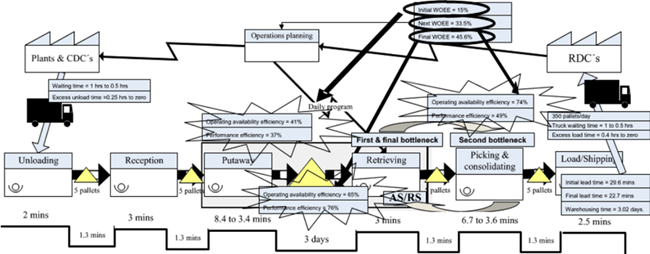Value stream mapping is the visual flow chart that portrays and enhances the formulation and manufacturing operations and also the information that controls the material flow through the operation.
Purpose of Value Stream in Warehouse Mapping Process
The use of value stream in warehouse mapping process is the sanctioned approach to identify and minimize the waste production in a development process by analyzing temperature, humidity and storage conditions inside the warehouse. It is the first step in a production process that helps in continuous improvement with minimum waste and loss and thus helps the organization to process efficiently in terms of its design, delivery and sustainability.
Warehouse functions render major complexity in the operations due to environmental changes inside and outside the warehouse, thus require the alliance of personals, system and mechanics to work efficiently for optimum achievement.
Warehouse mapping process is the graphical illustration of the activities that take place in a manufacturing process. These activities then determine the value of a company and its success. By the use of value stream in warehouse mapping process every step is scrutinized and ensured that they are streamlined and are in accordance with the standard operating procedures (SOP’s).
Steps for Warehouse Mapping Process
The important steps for starting the warehouse mapping process by using value stream are described below:
Step 01 – Setup a validation plan
The first and the foremost step in the warehouse mapping process is to setup a validation plan. That is the documentation of the actions taken by the company to improve the product and make it in compliance with the Good Manufacturing Practices (GMPs). The plan should include all the important steps and conditions that need to be taken care of in the mapping process that includes the personnel responsibilities, processes, equipments, temperature, pressure, humidity and the validation schedule.
Step 2 – Identification of risk areas and areas to be monitored
Every warehouse is different and so are the storage conditions. For instance, if the warehouse is large, the temperature fluctuation risks are higher. If the warehouse has a smaller space then the temperature will rise quickly thus damaging the product. So before starting the warehouse mapping process it is necessary to understand the storage environment and risk areas. To minimize the risks following steps should be considered:
- Installation of HVAC system in warehouse.
- Creating a Temperature gradient.
- Installation of space heaters and air conditioners.
- Adequate number of doors and windows.
- Change the layout of shelves.
Step 3 – Identification of product or product group
The most important step in the warehouse mapping process is to recognize and differentiate the products or set of products that use similar starting ingredients, passes through similar processes and use same equipments. The rule of thumb is to take the preeminent volumes first for mapping.
Step 4 – Information and current flow identification
Once the product group is identified the next step is to map the information and current flow. This involves the graphical representation of how the process is taking place at the moment. This is stated as “Current state mapping”. It starts with the understanding of customer requirements that may involve, time or availability, number of units per month, shipping schedules or any other specific requirements of a customer.
Step 5 – Observation and confirmation of processes
The mapping process is then started by visiting the warehouse to analyze the processes. In fact, it is critical to go to the working place and have the “Current state map”. For this purpose the value stream mapping team visits the warehouse floor at the end of process that can be the loading or shipping process and then walk back up to the value stream with analyzing each step of the process.
Step6 – Mapping the value Stream or flow
The analyzed processes are then discussed by the value stream team and then they start drawing the value stream and product flow. It is done either on large sheets pasted on walls or on large drawing boards. Process identifications are important in this aspect to identify any areas that needs improvisation.
Step 7 – Establish the implementation plan
It is the most important step in the warehouse mapping process. It is usually categorized in smaller phases for easy management and to attain the future state efficiently.
After the data is analyzed and process is mapped it is then checked if anything needs modification, for example, changing rack locations, shelves rearrangement needed, fans need to be increased. Each modification needed is also added in the mapping.
It is therefore important to note that value stream mapping process is conducted each year because as the future state is achieved it becomes the current state and then the mapping needs to be done again.
